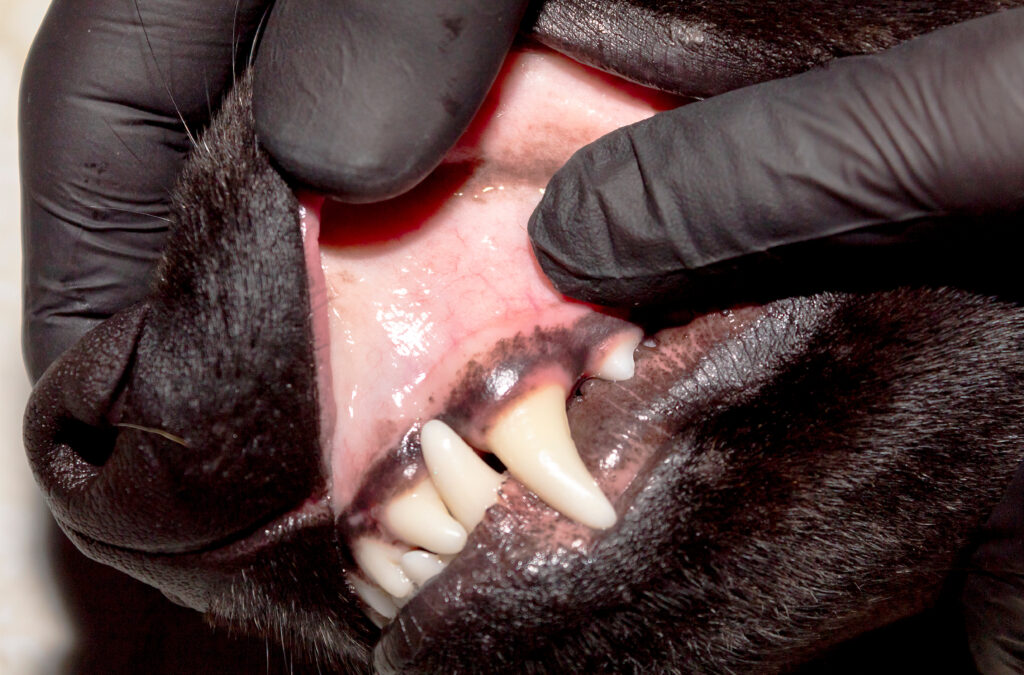Pale gums in dogs can be a sign that something is not right with your beloved pet. It’s a symptom that should never be overlooked. In this blog, we’ll explore the common causes of pale gums in dogs, what these symptoms may indicate, treatment options, and the importance of prompt veterinary care. We’ll also share tips on how pet owners like you can prevent this condition and what steps to take if they notice their dog has pale gums. For personalized advice and treatment, don’t hesitate to call Veazie Veterinary Clinic in Bangor, ME at (207) 941-8840.
Common Causes of Pale Gums in Dogs
Pale gums in dogs can be caused by a variety of factors. Understanding these can help in early detection and prompt treatment. These factors include:
- Anemia: This is a reduction in red blood cells and can be due to blood loss from injuries or internal issues like ulcers or parasites, or diseases that destroy red blood cells, such as immune-mediated hemolytic anemia, or even chronic diseases that disrupt red blood cell production.
- Blood Loss: Significant blood loss, whether external or internal, can lead to pale gums. If your pet experiences trauma or an injury which causes external bleeding, or if they are diagnosed with internal bleeding due to conditions like stomach ulcers, ruptured tumors, or coagulation disorders, they may exhibit pale gums.
- Circulatory Problems: Issues with blood circulation such as heart failure or shock can lead to pale gums.
- Respiratory Issues: Problems with breathing or oxygen exchange including lung disease that reduce oxygen absorption and airway obstructions can also cause pale gums.
- Toxins and Poisons: Exposure to certain toxins like rat poison or toxic plants that may cause internal bleeding or affect blood or organ function can lead to pale gums.
- Dehydration and Heatstroke: Dehydration, especially when severe, can make the gums appear paler than normal. Heatstroke can also lead to circulatory changes causing pale gums.
Pale gums in dogs can be an indicator of several health issues, some more serious than others. It can signify anything from mild dehydration to life-threatening conditions like internal bleeding or organ failure. It’s crucial to monitor your dog’s overall behavior and health if you notice pale gums. Lethargy, loss of appetite, or changes in drinking habits alongside pale gums are signs that your pet needs immediate veterinary attention.
Treatment Options for Pale Gums in Dogs
When a dog presents with pale gums, the treatment plan will vary depending on the underlying cause. Our team is equipped to perform extensive diagnostic testing to determine a cause and create the most effective treatment plan for your canine. From medications, to blood transfusions, respiratory support, or surgery, the team at Veazie Veterinary Clinic is here to provide the very best care for your dog.
The Importance of Prompt Veterinary Care
Seeking prompt veterinary care is essential when you notice pale gums in your dog. Early diagnosis and treatment can significantly improve the prognosis for many of the conditions associated with pale gums. At Veazie Veterinary Clinic, our team is equipped to diagnose and treat the underlying causes, ensuring your pet receives the best possible care.
Preventing Pale Gums in Dogs
Keeping your canine family member happy and healthy can help prevent pale gums in dogs. We’ve included some preventative tips below, but if you’re looking for more personalized advice, be sure to consult with your veterinarian to ensure your dog receives the best care suited to their needs.
- Regular Check-ups and Vaccinations: Consistent veterinary check-ups are crucial in maintaining your dog’s health. These visits allow your vet to monitor your pet’s overall condition and catch any early signs of diseases that could lead to pale gums. Vaccinations also play a key role in preventing diseases that can affect your dog’s blood and circulatory health.
- Balanced Diet and Proper Hydration: A balanced diet is essential for your dog’s overall health. High-quality dog food that meets all the nutritional needs can help prevent conditions like anemia, which is a common cause of pale gums. Ensure that your dog has access to clean water at all times, as dehydration can quickly lead to health issues.
- Parasite Control: Parasites, such as fleas, ticks, and intestinal worms, can cause blood loss or diseases that may result in pale gums. Regular parasite prevention treatments are essential in maintaining your dog’s health.
- Monitoring Exercise and Play: While exercise is vital for your dog’s health, it’s important to monitor their play and exercise routines. Overexertion, especially in hot weather, can lead to dehydration and heatstroke, which can manifest as pale gums. Ensure your dog has a balanced routine with adequate rest.
- Stress Reduction: Stress can impact your dog’s immune system and overall health. Creating a calming environment, maintaining a routine, and providing mental stimulation can help keep stress levels low.
Responding to Pale Gums in Your Dog
When you notice that your dog’s gums are paler than usual, it’s important to act quickly and thoughtfully. Here are some steps you should take:
- Stay Calm: Your calm demeanor can help keep your dog relaxed.
- Check for Other Symptoms: Look for signs like lethargy, difficulty breathing, or changes in behavior. These could indicate the severity of the situation.
- Call Veazie Veterinary Clinic: At the first sign of pale gums, call us at (207) 941-8840. Describe the symptoms and any other changes you’ve noticed in your dog.
- Follow Professional Advice: Our veterinary team may provide specific instructions over the phone based on your description. This might include bringing your dog in immediately for an examination.
- Transport Safely: When transporting your dog to the vet, make sure they are secure and comfortable. Use a pet carrier or a harness in the car, if necessary.
- Follow Vet Recommendations: After your visit, follow the treatment plan prescribed by your veterinarian meticulously.
- Monitor Your Dog: Keep a close watch on your dog’s behavior, appetite, and gum color following the vet’s advice.
Your Partner in Pet Health
At Veazie Veterinary Clinic, we understand how concerning it can be to see any signs of illness in your pet. We are here to be your partner in maintaining your dog’s health. If you’re worried about pale gums in your dog or have any other health concerns, please call us at (207) 941-8840. Our experienced team is ready to provide the care and support your pet needs.





